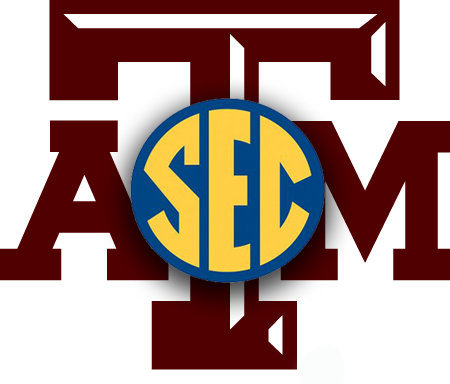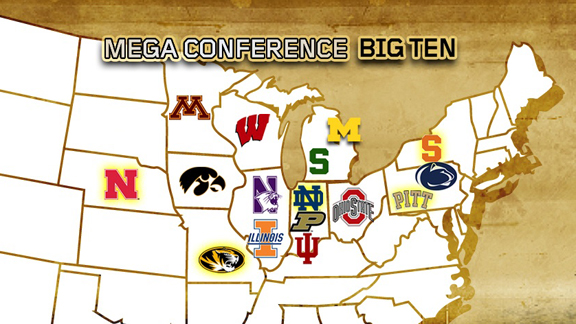Naturally, the reshaping of college football's landscape has brought up some questions for the future of the sport.
With so many teams switching conferences, will Texas A&M actually move to the SEC?
Is the end near for the Big XII?
What will the Landscape look like in five to ten years?
Will bigger conferences lead to the often asked for playoff system in college football?
Realignment is a tricky subject because there are so many moving parts to it. And we never really know what is going to happen five to ten years from now. That being said, here is what is most likely to happen.
Texas A&M is heading for the SEC, not this year but it could depart as early as at the end of the season.
The Aggies spent a good portion of the summer flirting with the possibility of relocation to the South Eastern Conference, and now that move seems to be all but certain. Even Oklahoma's president David Boren said to ESPN that A&M relocating is "highly likely" even with a threat of legal action by the Big XII against A&M. The fact of the matter is that the SEC is the most prominent conference in college football because of the success of schools like Alabama, Florida, LSU, and Auburn over the course of the last decade. It is only natural that other schools would want a piece of the pie not only because of the harvest of recruit potential, but also there would be a nice chunk of change coming to the schools in the SEC. The A&M to the SEC is a money grab, but if it benefits their university, why would they decline this invitation? The short answer is they would not. Expect the Aggies to be a part of the SEC as soon as they figure out a legal way around the pending lawsuit from the Big XII if they left.
Speaking of the Big XII, there is simply no room for them in the future landscape of college football.
Yes the Big XII has been a very strong conference over the course of the past decade and yes the presidents of schools in the Big XII have pledged their television rights to the conference, but the fact remains the Big XII is going down for a few reasons.
- The conference has only been around since 1994, so there is not as much deep rooted tradition that exists in other conferences such as the Big Ten. So there is far less ground for the "tradition" arguments to stand on.
- The Big XII have lost 2 teams to the realignment already (Nebraska and Colorado) and Texas A&M is on it's way out. The fact of the matter remains that if the Big XII were as stable as the Presidents say it is, then it would not loose a quarter of it's conference to realignment. Rather they would try to add more teams to the conference.
- The University of Texas has gained to much power for the conference, and will likely go independent because they generate so much money on their own. If Texas leaves the conference, the other nine schools (excluding A&M because they are all but gone) will follow in order to try and match the money that Texas is making through their own television networks.
The Big XII will go down kicking and screaming, but at the end of the day, there is no future for this conference.
So if College football's landscape is changing, what will it look like in five to ten years?
Although it will be tough to come up with conference names, there will be four very big versions of the SEC, Pac 12, Big Ten, and ACC left standing.
The Big Ten, SEC, Pac 12, and ACC are the biggest conferences remaining and they will only get bigger as the college landscape continues to shift. Geographically, it is very possible to divide the college football world into four regions. The SEC will likely have it's current schools, some of the southern schools from the Big XII and most of the schools in the Big East below the Mason-Dixon line. The ACC will most likely have the Upper portion of the Big East (Pitt Syracuse Maryland etc) and a few other schools that make sense geographically. The Big Ten will expand South and West to absorb the upper half of the Big XII and other schools as far west as Wyoming. And the rest of the West will be part of the new look Pac 12. There will be two or four divisions within these conferences depending on the sizes of them and a far more interesting conference tournament.
So if the college football landscape does shift this much, it is time to answer the sport's ultimate question: Will expansion lead to a much desired playoff system in college football?
Expansion does make a college football playoff system more attainable, but unless something drastic happens over the next five or ten years, college football will not have a playoff system.
If the college football landscape does undergo this dramatic makeover to four super conferences, then a playoff system could be sculpted. Split the conferences up into divisions, for the sake of argument we will say two, and have the division winners meet in an eight team playoff format using the big bowl games as tournament games; so the Cotton Bowl, Capital One Bowl, Fiesta Bowl, Orange Bowl, Rose Bowl, Sugar Bowl and BCS National Championship games would still be played. If these new conferences are too big, then it could still be split up into four divisions with a sixteen team playoff format. And the other teams that do not make the top 16 will still get to play their respective bowl games if they win six games.
That may sound like a good idea, but the individuals in charge of the BCS playoff system will not budge on this issue because they make too much money off of the current system. Even though a playoff system could generate just as much, most likely more, revenue for participating schools.
Relocation can be a scary thing for anyone at first, but eventually, we all get used to it. And the same philosophy can be applied to the likely shift in college football's landscape.






No comments:
Post a Comment